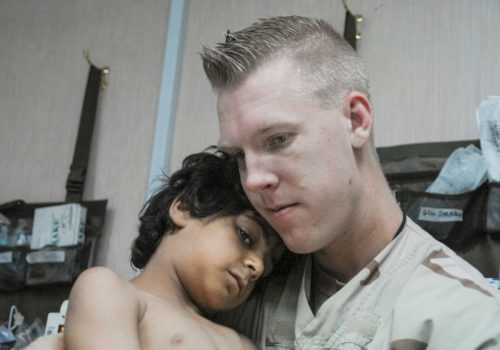Disco Night Sept 11 is a magnificent hybrid work. Part war story and part family album, it shares with the latter the fabric cover, relatively small photographs, unfolding pages, captions, and it even achieves the same cathartic effect, for soldiers, their families, the United States and the author Peter Van Agtmael himself. A list of scenes that were witnessed but not photographed concludes his undeniably personal essay and study that includes a photograph of a misty Swedish forest which Van Agtmael visited, somber and confused, after his first trip to Iraq.
“Disco Night Sept 11” reads a sign outside an American motel. This is the irony of a conflict that has changed its appearance since September 11th, 2001, and whose consequences are still being felt. It’s also the date to which Peter Van Agtmael, then a student in modern history at Yale, anchored his obsession with 21st-century American wars. Viewing photography as a way to understand them, he spent several years covering the wars in Iraq and Afghanistan for the international press, in the field and from the United States, with a complex vocabulary rejecting immediacy—one of the strengths of the book is the way its texts stop the reader, drawing out one’s exposure to the image, allowing its various scenes to unfold. First we see two men in their thirties chatting in a hotel hallways, then we realize that one of them is missing an arm. First we see a sculpture, then we see the figure of a screaming woman, her hair on fire, her hands clasped over her mouth in pain. First we see a soldier posing before rubble, then we see the gallons of blood splattered against the walls, a shoe on the end of his rifle, and a disturbing grin on his lips. “It had been an unusually violent day mixing absurdity with danger,” writes Van Agtmael later about the overwhelming reality of this modern war whose mechanisms, codes and iconography he has continuously dissect and deconstruct.
Disco Night Sept 11 offers memories of the dead to families, meaning to traumatized soldiers, and to the United States, mourning over a painful mistake that seems only to have spared the town of Nineveh, in Iraq. In the bible, Nineveh was spared by God, reads the caption. In 2009 in Nineveh, far from the consequences of some international dichotomy, American soldiers struggle to ride donkeys, to the amusement of onlooking Iraqis who have never seen an American patrol. Van Agtmael rejects the notion of the enemy for that of the individual in order to write a total history, as offered by the Annales School. The protagonists come together, first in the words of Van Agtmael and the soldiers, written on the walls of bases and camps and torn sheets of paper. The first piece of graffiti reproduced in the book reads, “Second Tour: Hope I Don’t Die,” and it was for a long time the name Van Agtmael had given to the series, but it could also appear in a bubble above the face of Brian Cowdey, surrounded by his family and lost—Cowdey was killed during his fourth deployment to Afghanistan, we learn in the caption. The voices blend together, visually and textually: Iraqis, Afghans, soldiers, provocative, tender, moved, frightened, weakened, reasonable, enraged, drugged, sensitive and dead, their families, President Obama, the media, the photographer and son of worried parents.
BOOK
Dico Night: Sept 11
By Peter Van Agtmael
Red Hook Editions
Dimensions: 8.5″ x 10.5″
Pages: 276
188 Photographs
Design : Yolanda Cuomo Design
45$
http://www.magnumphotos.com/PetervanAgtmael
http://www.magnumphotos.com/Store/Product/Disco-Night-Sept.-11-2K1HRG5YVNLJ.html
http://www.petervanagtmael.net
http://www.redhookeditions.com
















